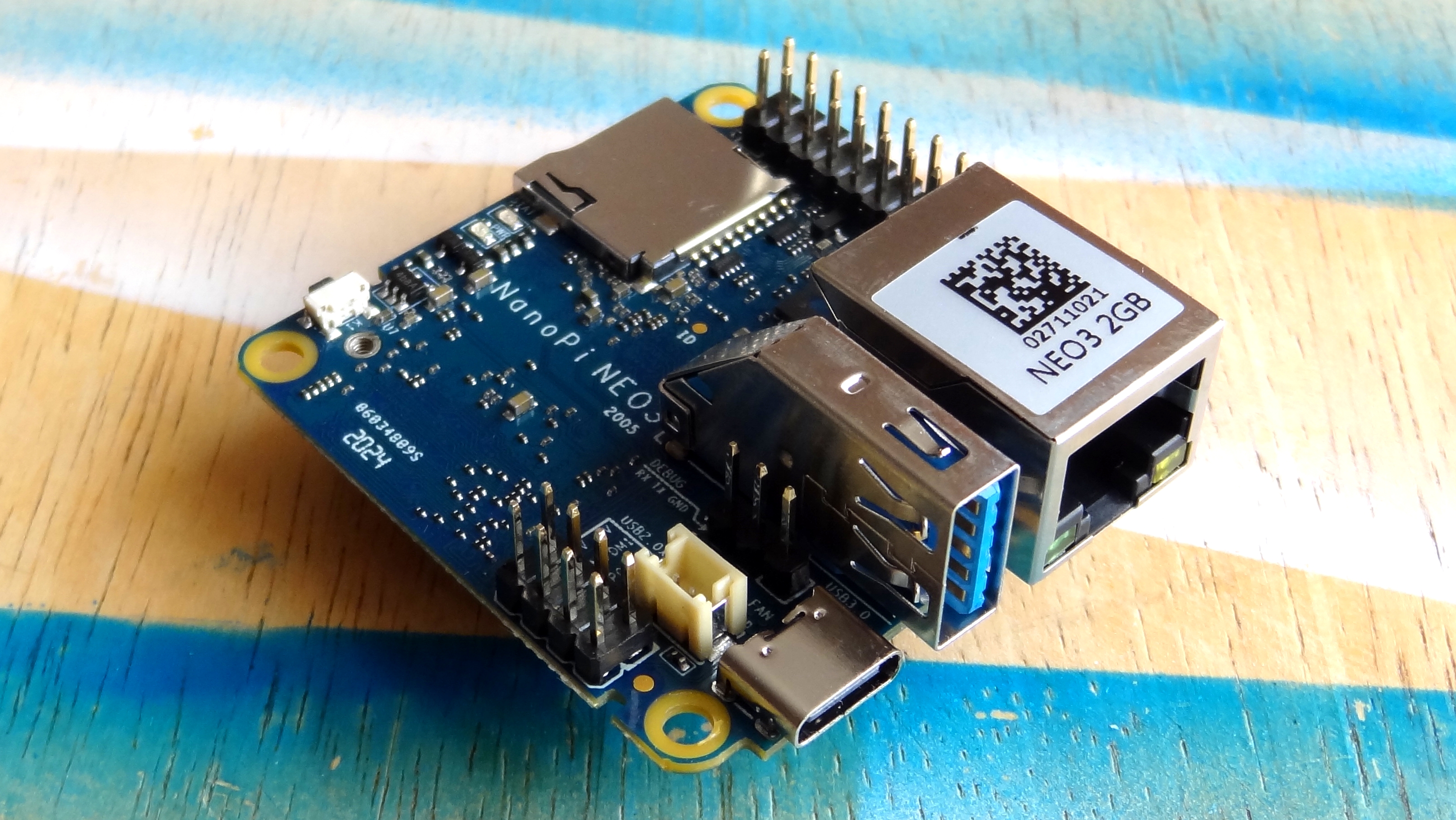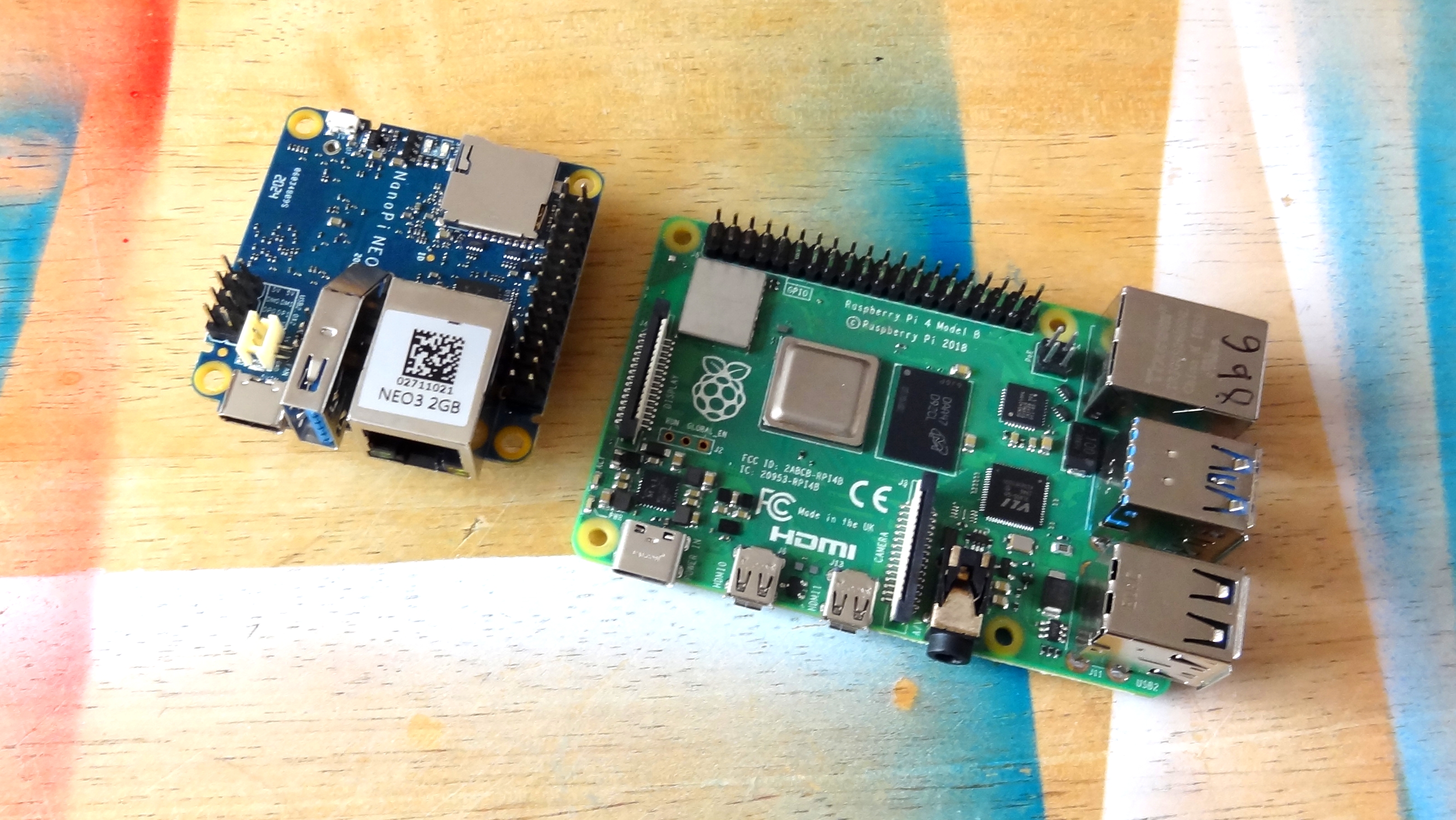Tom's Hardware Verdict
For just $20, the NanoPi NEO3 can be a server on your network, but it won't replace your Raspberry Pi.
Pros
- +
Small size
- +
Powerful package
- +
USB 3 port
Cons
- -
GPIO not Raspberry Pi compatible
Why you can trust Tom's Hardware
The competitors for the Raspberry Pis crown are plentiful and each produce a number of boards that serve a specific purpose. The latest board from FRIENDLY ELEC is the $20 ($25 for 2GB of RAM, $54 direct from Amazon) NanoPi NEO3 which offers similar performance to the Raspberry Pi 3, but in a much smaller package. But what’s the catch? In the case of the NanoPi NEO3 the catch is that this is not a general purpose computer, but rather something from which we can build networked appliances and Internet of Things (IoT) devices.
Specifications of the NanoPi NEO3
At the heart of the NanoPi NEO3 is a RockChip RK3328 Quad Core 64bit Cortex A53. The Cortex A53 running between 400MHz and 1.296GHz provides solid performance, similar to the 1.2GHz quad core ARM Cortex A53 found in the Raspberry Pi 3. The 1GB or 2GB of DDR4 is plenty for the tasks that this board will be performing. We chose to max out the RAM and went for the 2GB model for this review.
The NanoPi NEO3 is not a board for general purpose use, made clear by the lack of any form of connection for displays. For the NanoPi NEO3 a life of quiet networked applications is all it shall undertake while looking cute in its optional white plastic case. Unlike other boards in the range, the NanoPi NEO3 does not come with any onboard flash storage, rather a single microSD card is our only source of bootable storage.
| System on Chip | RockChip RK3328, Quad-core 64-bit high-performance Cortex A53 | Row 0 - Cell 2 |
| RAM | 1GB/2GB DDR4 | Row 1 - Cell 2 |
| LAN | 10/100/1000M Ethernet with unique MAC | Row 2 - Cell 2 |
| USB | 1x USB3.0 Type A and 2x USB2.0 on 2.54mm pin header | Row 3 - Cell 2 |
| MicroSD | One slot for system boot and storage | Row 4 - Cell 2 |
| Fan | 2Pin JST ZH 1.5mm Connector for 5V Fan | Row 5 - Cell 2 |
| GPIO | 2.54mm pitch 26 pin-header, include I2C, UART, SPI, I2S, GPIO | Row 6 - Cell 2 |
| Serial Debug Port | 2.54mm pitch 3 pin-header, 1500000bps | Row 7 - Cell 2 |
| Power | 5V/1A, via Type-C or GPIO | Row 8 - Cell 2 |
Design of the NanoPi NEO3
The NanoPi NEO3 is deceptively small. Measuring just 1.9 x 1.9 x 0.9 inches (48 x 48 x 24mm) which makes it smaller than the Raspberry Pi 3 A+ 2.5 x 2.2 x 0.5 inches (65 x 56 x 12mm) but more square than a Raspberry Pi Zero which measures 2.5 x 1.2 x 0.5 inches (65 x 30 x 12mm).
The PCB is well thought out with a single USB 3 port, Gigabit Ethernet and a USB C port for power, all things the Raspberry PI 3 doesn’t have (though the Raspberry Pi 4 does). On the underside of the NanoPi NEO3 is a generous heatsink which provides the passive cooling needed for the board. If additional active cooling is required, a 2 pin JST fan header is provided to power a 5V fan. Our review model operated at a maximum temperature of 55 Celsius while serving HD video over our network. The 55 Celsius temp that we saw was below the maximum maximum working temperature of 70 Celsius, but it would be advisable to have active cooling if you are planning to embed the NanoPi NEO3 in a project.
Using the NanoPi NEO3 GPIO
The NanoPi NEO3 features a 26 pin GPIO that may look similar to that used with the original Raspberry Pi, and offer a similar pinout for I2C, SPI, UART I2S and digital IO. But this GPIO is not directly compatible with Raspberry Pi addo-ns. So your HATs, even the best Raspberry Pi HATs, will have to stay with your Raspberry Pi.
To use the GPIO we downloaded Friendlycore, a version of UbuntuCore 18.04 for the NanoPi boards and then compiled WiringPi, a C library and tool to work with the GPIO. The installation process was not perfect and regularly told us that our board was not recognised. The same was true for a version of RPi.GPIO, a fork of the original Python library to use the Raspberry Pi GPIO.
Get Tom's Hardware's best news and in-depth reviews, straight to your inbox.
So how could we test the GPIO of the NanoPi NEO3? We used the BASH terminal to directly connect and use the GPIO. Using the Friendly ARM wiki as a reference, we learnt the GPIO reference for a pin and then used a few BASH commands to connect, setup and control a single pin. Basic GPIO control is possible, but if what you want to do is make LEDs flash and build cool robots, then stick with the Raspberry Pi. The second set of GPIO pins provide a USB 2.0 breakout for additional connectivity.
Use Cases for the NanoPi NEO3
So if this isn’t a “Raspberry Pi Killer” then what is it? The NanoPi NEO3 is made for networked storage projects. Using the FriendlyWrt OS, we quickly created a network share that served up our 4TB USB 3 drive to all devices on our network using the SMB protocol.
The combination of USB 3 and Gigabit Ethernet in such a small package means that the NanoPi NEO3 can be easily added into a home network, with minimal fuss and wires. The choice of FriendlyCore (Ubuntu) and FriendlyWrt enables confident Linux users to get hands on with Ubuntu and build their own network storage appliance or low power tool.
But for those of us that prefer something simpler, then FriendlyWrt is the right mix of simplicity and function as it abstracts away technical subjects such as network storage, VPN, torrent server and ad blocking for your whole home network.
Bottom Line
The short answer is that this is no Raspberry Pi. What it is, is a cost effective alternative that focuses on networked applications. If you need quick and cheap network storage, and don’t mind getting your hands dirty, then the NanoPi NEO3 is a great little board to solve that problem.

Les Pounder is an associate editor at Tom's Hardware. He is a creative technologist and for seven years has created projects to educate and inspire minds both young and old. He has worked with the Raspberry Pi Foundation to write and deliver their teacher training program "Picademy".
-
zeroidea Replyacme64 said:shoulda been dual ethernet, then you can run something like pfsense
That's the NanoPi R2S






